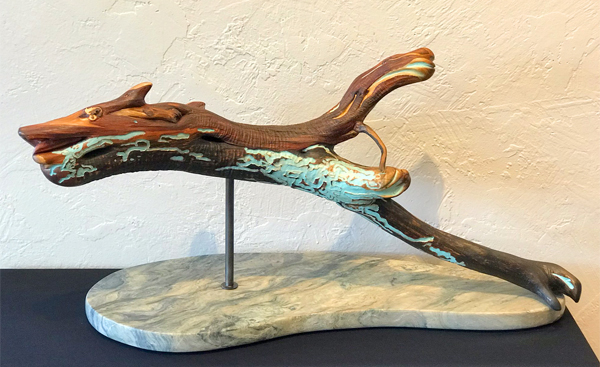Art that leads the artist

Seawolf
Juniper monosperma, partially ebonized with a traditional vinegar and steel wool solution, clay paint. Granite base by Villanueva Granite.
15x30"
$500
In early March we reluctantly cut down a large native juniper to make space for a new garage. We had counted 165 rings in a nearby tree... this one was larger and certainly at least that old. I selected a thick branched piece to make a table base. In May I began stripping the bark, then set it aside. When I came back later I saw a wolf’s head. Removing the bark had revealed intricate channels carved by beetles, which looked like water streaming from the mouth. Turning it over, I saw a fish. The entire piece was swimming. It had become a sculpture. With no idea where it was going, for weeks I followed where the wood led. By mid August it developed into a swimming wolf- fish with sea foam spattered down the sides. |
The work simply evolved, but I didn’t quite know what to make of it. It seemed the ancient juniper had told me what it wanted to become, but what was it? This is New Mexico, a high desert, where one need not even swim to cross the “mighty” Rio Grande. Coyotes are far more common than wolves. Where did the water wolf come from? When it was nearly done, I discovered a new National Geographic documentary about wolves on the coast of British Columbia which swim and eat mostly salmon and seals. They are smaller due to this diet, and are a rusty brown and black... exactly the color of this wood. The next day I saw an article in the current High Country News about a hybrid wolf, a blend of smaller coastal and larger inland Canadian wolves. The working title of this piece from day one has been sea wolf. Coincidence? Now, back to that woodpile to see what other forms await. |